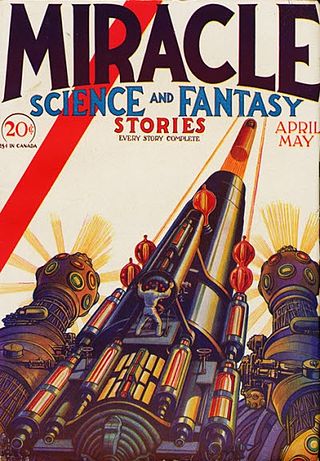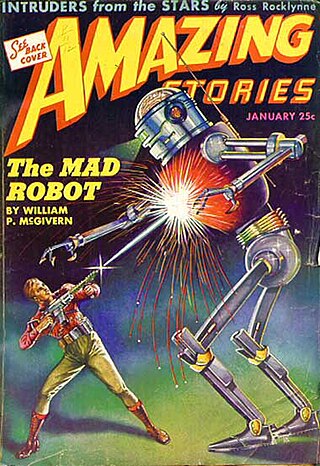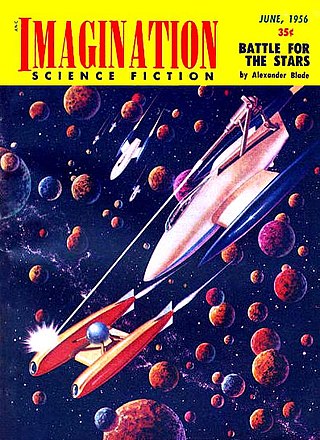Related Research Articles

Robert Anson Heinlein was an American science fiction author, aeronautical engineer, and naval officer. Sometimes called the "dean of science fiction writers", he was among the first to emphasize scientific accuracy in his fiction, and was thus a pioneer of the subgenre of hard science fiction. His published works, both fiction and non-fiction, express admiration for competence and emphasize the value of critical thinking. His plots often posed provocative situations which challenged conventional social mores. His work continues to have an influence on the science-fiction genre, and on modern culture more generally.

Starship Troopers is a military science fiction novel by American writer Robert A. Heinlein. Written in a few weeks in reaction to the US suspending nuclear tests, the story was first published as a two-part serial in The Magazine of Fantasy & Science Fiction as Starship Soldier, and published as a book by G. P. Putnam's Sons on November 5, 1959.

Alien invasion or space invasion is a common feature in science fiction stories and film, in which extraterrestrial lifeforms invade the Earth to exterminate and supplant human life, enslave it, harvest people for food, steal the planet's resources, or destroy the planet altogether. It can be considered as a science-fiction subgenre of the invasion literature, expanded by H. G. Wells's seminal alien invasion novel The War of the Worlds.
Science fiction is a film genre that uses speculative, fictional science-based depictions of phenomena that are not fully accepted by mainstream science, such as extraterrestrial lifeforms, spacecraft, robots, cyborgs, dinosaurs, mutants, interstellar travel, time travel, or other technologies. Science fiction films have often been used to focus on political or social issues, and to explore philosophical issues like the human condition.

Science fantasy is a hybrid genre within speculative fiction that simultaneously draws upon or combines tropes and elements from both science fiction and fantasy. In a conventional science fiction story, the world is presented as being scientifically logical; while a conventional fantasy story contains mostly supernatural and artistic elements that disregard the scientific laws of the real world. The world of science fantasy, however, is laid out to be scientifically logical and often supplied with hard science–like explanations of any supernatural elements.

Military science fiction is a subgenre of science fiction that depicts the use of science fiction technology, including spaceships and weapons, for military purposes and usually principal characters who are members of a military organization, usually during a war; occurring sometimes in outer space or on a different planet or planets. It exists in a range of media, including literature, comics, film, television and video games.

Strange and exotic weapons are a recurring feature in science fiction. In some cases, weapons first introduced in science fiction have been made a reality; other science-fiction weapons remain purely fictional, and are often beyond the realms of known physical possibility.
Publication of comic strips and comic books focusing on science fiction became increasingly common during the early 1930s in newspapers published in the United States. They have since spread to many countries around the world.

The Honorverse is a military science fiction book series, its two subseries, two prequel series, and anthologies created by David Weber and published by Baen Books. They are centered on the space navy career of the principal protagonist Honor Harrington. The books have made The New York Times Best Seller list.

Space warfare is hypothetical combat in which one or more belligerents are situated in outer space. The scope of space warfare therefore includes ground-to-space warfare, such as attacking satellites from the Earth; space-to-space warfare, such as satellites attacking satellites; and space-to-ground warfare, such as satellites attacking Earth-based targets. Space warfare in fiction is thus sub-genre and theme of science fiction, where it is portrayed with a range of realism and plausibility.
The exploration of politics in science fiction is arguably older than the identification of the genre. One of the earliest works of modern science fiction, H. G. Wells’ The Time Machine, is an extrapolation of the class structure of the United Kingdom of his time, an extreme form of social Darwinism; during tens of thousands of years, human beings have evolved into two different species based on their social class.

Robinsonade is a literary genre of fiction wherein the protagonist is suddenly separated from civilization, usually by being shipwrecked or marooned on a secluded and uninhabited island, and must improvise the means of their survival from the limited resources at hand. The genre takes its name from the 1719 novel Robinson Crusoe by Daniel Defoe. The success of this novel spawned so many imitations that its name was used to define a genre, which is sometimes described simply as a "desert island story" or a "castaway narrative".

First contact is a common science fiction theme about the first meeting between humans and extraterrestrial life, or of any sentient species' first encounter with another one, given they are from different planets or natural satellites. The theme allows writers to explore such topics such as xenophobia, transcendentalism, and basic linguistics by adapting the anthropological topic of first contact to extraterrestrial cultures.
Social science fiction is a subgenre of science fiction, usually soft science fiction, concerned less with technology/space opera and more with speculation about society. In other words, it "absorbs and discusses anthropology" and speculates about human behavior and interactions.
Space Western is a subgenre of science fiction that uses the themes and tropes of Westerns within science-fiction stories in an outer space setting. Subtle influences may include exploration of new, lawless frontiers, while more overt influences may feature literal cowboys in outer space who use rayguns and ride robotic horses. Although initially popular, a strong backlash against perceived hack writing caused the genre to become a subtler influence until the 1980s, when it regained popularity. A further critical reappraisal occurred during the 2000s due to critical acclaim for Firefly.
The planetary systems of stars other than the Sun and the Solar System are a staple element in many works of the science fiction genre.

The following outline is provided as an overview of and topical guide to science fiction:

Space opera is a subgenre of science fiction that emphasizes space warfare, with use of melodramatic, risk-taking space adventures, relationships, and chivalric romance. Set mainly or entirely in outer space, it features technological and social advancements in faster-than-light travel, futuristic weapons, and sophisticated technology, on a backdrop of galactic empires and interstellar wars with fictional aliens, often in fictional galaxies. The term has no relation to opera music, but is instead a play on the terms "soap opera", a melodramatic television series, and "horse opera", which was coined during the 1930s to indicate a clichéd and formulaic Western film. Space operas emerged in the 1930s and continue to be produced in literature, film, comics, television, video games and board games.

Space travel, or space flight is a classic science-fiction theme that has captivated the public and is almost archetypal for science fiction. Space travel, interplanetary or interstellar, is usually performed in space ships, and spacecraft propulsion in various works ranges from the scientifically plausible to the totally fictitious.
References
- ↑ Andrew M. Butler (2005). "Philip K. Dick. Do Androids Dream of Electric Sheep?". In David Johnson (ed.). The Popular And The Canonical: Debating Twentieth-century Literature 1940–2000. Routledge (UK). p. 113. ISBN 0-415-35169-3.
- ↑ Eugene F. Mallove and Gregory L. Matloff (June 1989). The Starflight Handbook: A Pioneer's Guide to Interstellar Travel. Wiley. pp. 20. ISBN 0-471-61912-4.
- ↑ August 1939 Astounding Science-Fiction August 1939
- ↑ See (e.g.) E. E. "Doc" Smith (1951), Grey Lensman, chapter 23
- ↑ Uses the Death Star as an exercise in calculus
- ↑ A page on "How to Destroy the Earth."
- ↑ Star Wars Technical Commentaries on the Death Stars Archived November 28, 2006, at the Wayback Machine
- ↑ On Basilisk Station (1993)
- ↑ The Honor of the Queen (1993 ISBN 0-671-57864-2)
- ↑ The Short Victorious War (1994)
- ↑ Okuda, Michael & Denise (1997). The Star Trek Encyclopedia. New York City: Pocket Books. ISBN 0-671-53607-9. Images accessible at 2265-2370 Ranks. Spike's Star Trek Page Rank Chart.
- ↑ Swanson, Roy Arthur: “The True, the False, and the Truly False: Lucian’s Philosophical Science Fiction”, Science Fiction Studies, Vol. 3, No. 3 (Nov. 1976), pp. 227–239
- 1 2 Brian Stableford (2003-12-08). "Science fiction before the genre". In Edward James and Farah Mendlesohn (ed.). The Cambridge Companion to Science Fiction . Cambridge University Press. pp. 20–21. ISBN 0-521-01657-6.
- ↑ Antulio J. Echevarria II. "Challenging Transformation's Clichés" (PDF). Strategic Studies Institute, U.S. Army War College. Retrieved 2007-01-31.
- ↑ Darren Harris-Fain (2005). "After the New Wave, 1970–1976". Understanding contemporary American science fiction: the age of maturity, 1970-2000. Univ of South Carolina Press. pp. 55–57. ISBN 1-57003-585-7.
- 1 2 3 Brooks Landon (2002). "From the Steam Man to the Stars". Science Fiction After 1900: From the Steam Man to the Stars. Routledge (UK). p. 70. ISBN 0-415-93888-0.
- ↑ H. Bruce Franklin (1990). War Stars: The Superweapon and the American Imagination. Oxford University Press. p. 200. ISBN 0-19-506692-8.
- ↑ Edison Conquest of Mars, Introduction Robert Godwin, page 6, Apoge 2005
- ↑ David Pringle (2000-01-30). "What is this thing called space opera?". In Gary Westfahl (ed.). Space and Beyond: The Frontier Theme in Science Fiction. Greenwood Press. pp. 40–41. ISBN 0-313-30846-2.
- ↑ Thomas D. Clareson (December 1992). Understanding Contemporary American Science Fiction: The Formative Period, (1926-1970). University of South Carolina Press. pp. 17–18. ISBN 0-87249-870-0.
- ↑ Jas Elsner, Joan-Pau Ribiés (1999). Voyages and Visions: Towards a Cultural History of Travel. Reaktion Books. p. 264. ISBN 1-86189-020-6.
- ↑ David G. Hartwell, Kathryn Cramer, The Space Opera Renaissance, Tor Books, ISBN 0-7653-0617-4. Introduction, p. 251
- ↑ "23 Best Military Science Fiction Books - The Best Sci Fi Books". 14 March 2015.
- ↑ Westfahl, Gary, ed. (2005). The Greenwood Encyclopedia of Science Fiction and Fantasy. Greenwood Publishing Group. p. 888. ISBN 9780313329524.
- 1 2 3 Green, Paul (2009). Encyclopedia of Weird Westerns. McFarland Publishing. ISBN 9780786458004.
- ↑ Lilly, Nathan E. (2009-11-30). "The Emancipation of Bat Durston". Strange Horizons . Archived from the original on 2014-03-14. Retrieved 2014-03-14.
- ↑ Abbott, Jon (2006). Irwin Allen Television Productions, 1964-1970: A Critical History of Voyage to the Bottom of the Sea, Lost in Space, The Time Tunnel and Land of the Giants. Jefferson, N.C: McFarland Publishing. p. 131. ISBN 0786486627.
- ↑ Williams, Owen (2014-07-24). "Peter Hyams Film By Film". Empire . Retrieved 2019-07-03.
- ↑ Steinberg, Don (2011-07-22). "Hollywood Frontiers: Outer Space and the Wild West". The Wall Street Journal . Retrieved 2014-03-15.